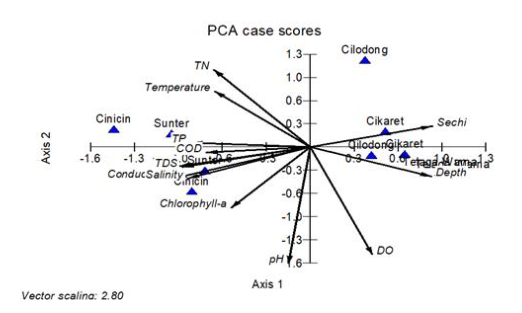Physical-Chemical Characteristic and Trophic Status of Some Small Lakes in Ciliwung Watershed, West Java Indonesia
DOI:
https://doi.org/10.51264/inajl.v2i2.15Keywords:
Characteristic, Ciliwung, physical-chemical, small lakesAbstract
Small lakes are important freshwater resources to support the quality of human life. However, small lakes in the watershed are becoming threatened ecosystems because of increasing land-use changes and anthropogenic activity. The study aimed to determine characteristic physical-chemical parameters and trophic status some small lake in Ciliwung Watershed to support the sustainable management of small lakes in the Ciliwung watershed in preventing eutrophication effects. The data was collected in April and June 2021. Measurement and analysis of water quality parameters were conducted by insitu and Laboratory. Some parameters were not in accordance with the Government Regulation number 22/2021 for class II water quality criteria (WQC), including TSS (>50 mg.L-1)., TP (>0.03 mg.L-1), COD (>25 mg.L-1) and DO (<3 mg.L-1), especially for Lake Sunter and Lake Cincin.There are two groups of lakes based on water quality and trophic status. Lake Telaga Warna Lake Cikaret, and Lake Cilodong were classified as eutrophic while lake Sunter and Lake Cincin were classified as hypereutrophic lake Lake Telaga Warna, Lake Cikaret, and Lake Cilodong, located at the upper and middle watershed, are eutrophic, characterized by deeper bottom and higher Secchi depth. At the lower watershed, Lake Sunter and Lake Cincin are hypereutrophic characterized by higher nutrients (TN and TP), COD, temperature, conductivity, salinity, and TDS. The downstream area was a densely populated area that contributed high pollution from upstream and middle of Ciliwung watershed.
References
Bhateria R, Jain D. 2016. Water quality assessment of lake water: a review Sustainable Water Resources Management volume 2, pages161–173 (2016)
Carlson R E, Simpson J. 1996. A coordinator’s guide to volunteer lake monitoring methods. North American Lake Management Society. 96 pp.
Chorus I, Falconer IR, Salas HJ, Bartram J. 2000. Health risks caused by freshwater cyanobacteria in recreational waters. J Toxicol Environ Health B Crit Rev Oct-Dec 2000;3(4):323-47. DOI: 10.1080/109374000436364
Department of Public Work of DKI Directorate of water Resources, River and Lake. 2010. Document of Environmental Impact Analysis related to Environmental Management Plant and Environmental Monitoring Plant.
Dokulil, M. T. and K. Teubner. 2011. Eutrophication and Climate Change: Present situation and Future Scenarios in EUTROPHICATION: Causes, Consequence, and Control (A. A. Ansari, S. Singh Gill, G. R. Lanza, W. Rast: Eds), Springer Science Business Media BV.
Falconer, I., Bartram, J., Chorus, I., Kuiper-Goodman, T., Utkilen, H., Burch, M. and Codd, G.A. (1999) Safe levels and practices, in I. Chorus and J. Bartram (eds.), Toxic Cyanobacteria in Water: a Guide to their Public Health Consequences, Monitoring and Management, Spon, London, United Kingdom, pp. 155–178.
Henny C, Meutia A A. 2014. Urban lakes in megacity Jakarta: risk and management plan for future sustainability. Procedia Environmental Sciences 20:737–746 https://doi.org/10.1016/j.proenv.2014.03.088
Henny C, Meutia AA. 2014. Henny C, Meutia AA. 2014. Water Quality and Quantity Issues of Urban Lakes in Megacity Jakarta. LIMNOTEK Perairan Darat Tropis di Indonesia 21(2): 145–15
Ho JC, Michalak AM. 2015. Challenges in tracking harmful algal blooms: A synthesis of evidence from Lake Erie . J. Great Lakes Res. 41, 317–325. https://doi.org/10.1016/j.jglr.2015.01.001
Hwang S. 2020. Eutrophication and the Ecological Health Risk. Int. J. Environ. Research and . Public Health 17, 6332 ; https://doi.org/10.3390/ijerph17176332
Jøgensen SE. 1980. Lake Management, Pergamon Press Ltd. Oxford-Great Britain,167 pp.
Ladwig R, Furusato E, Kirillin G, Hinkelmann R. 2018. Water 10,186 doi;10.3390/w10020186
Mara?l?o?lu F & Arif Gönülol, 2014. Phytoplankton Community, Functional Classification and Trophic State Indices of Yedik?r Dam Lake (Amasya). J. BIOL. ENVIRON. SCI., 8(24), 133-141
Nesseli-Flores J 2008 Urban Lake: Ecosystem at Risk, Worthy of the Best Care Proceeding of Taal 2007 12th World Lake Conference: 1333-1337
Osborne PL. 2005. Eutrophication of shallow tropical lake. In: The Lake Handbook: Restoration and Rehabilitation. PE O’Sulivane & CS Reynolds (Eds). (2): 299 pp. ISBN : 063204795X
Prihantini, N. Betawati, W. Wardhana, D. Hendrayanti, A. Widtawan, Y. Aryani, & R. Rianto, 2008. Biodiversity of Cyanobacteria at Several Lakes in Jakarta, Depok and Bogor. MAKARA SAINS. 2(1): 44- 54
Rusydi AF. 2018. Correlation between conductivity and total dissolved solid in various type of water: A review. IOP Conf. Series: Earth and Environmental Science 118 (2018) 012019
Sinha E, Michalak AM, Balaji V. 2017. Eutrophication will increase during the 21st century as a result of precipitation changes. Science Vol. 357, Issue 6349, pp. 405-408
DOI: 10.1126/science.aan2409
Wakhid W, Krisanti M, Rauf A, Sumertajaya I M. 2020. Aquatic insect assemblages in four urban lakes of Bogor, West Java, Indonesia. Biodiversitas Journal of Biological Diversity 21(7):3047-3056.
World Health Organisation. 2002. Eutrophication and Health. European Commission, Luxembourg.128pp. ISBN 92-894-4413-4
Yu D, Xie P, Zeng C, Xie L, Chen J. 2016. Yu D, Xie P, Zeng C, Xie L, Chen J. 2016. Ecological Engineering. Ecological Engineering, 87, 246-253 https://doi.org/10.1016/j.ecoleng.2015.11.039
Sulastri. (2002). Spatial and temporal distribution of phytoplankton in Lake Maninjau, West Sumatra. Proceeding of the International Symposium on Land Management and Biodiversity in South East Asia. (pp. 403-408). Bali, Indonesia.
Sulastri, Harsono E K, Suryono T and Ridwansyah I 2008 Land Use, Water Quality, and Phytoplankton Structure Community in Some Small Lakes West Jawa Oseanologi dan Limnologi di Indonesia (OLDI) 34(2): 307–322
Sulastri, Henny C, Arianto AB. 2019. Phytoplankton Composition and The Occurrence of Cyanobacterial Bloom in Lake Maninjau, Indonesia. IOP Conf. Series: Earth and Environmental Science 380 (2019) 012020.
Supriyadi A, Syaufina L, Iin Ichwandi I. 2015. Ealuasi Kebijakan Pengelolaan Situ Cikaret, Kabupaten Bogor. LIMNOTEK, 22 (1): 52-63 [in Indonesian]







